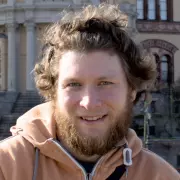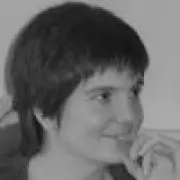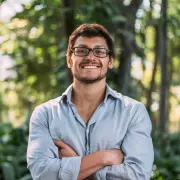09/04/2025, 15:30 — 16:30 — Room 6.2.33, Faculty of Sciences of the Universidade de Lisboa
Tim Henke, Universidade do Porto
The projective equivalence of the Hitchin and the Knizhnik–Zamolodchikov connections
The Pauly Isomorphism identifies the geometric quantisation of the moduli space of parabolic bundles over a pointed Riemann surface with the space of conformal blocks associated to the same surface. This isomorphism is the mathematical formalisation of the physical CS/WZNW duality. Both spades depend crucially on the complex structure of the surface, but the physical duality is understood to be purely topological. This implies that the Pauly Isomorphism should be projectively flat with respect to variations of the complex structure. These are given by the Hitchin connection for the moduli space and the Knizhnik-Zamolodchikov connection on the sheaf of conformal blocks. For higher genera the equivalence follows from the non-parabolic case. We treat the genus 0 case that is crucial for developing topological invariants from the moduli theory.
I will explain the construction of the different spaces, define the bundles on both sides of the isomorphism and sketch the ideas that go into the proof.
09/04/2025, 14:30 — 15:30 — Room 6.2.33, Faculty of Sciences of the Universidade de Lisboa
Helena Reis, Universidade do Porto
Construction of algebraic vector fields out of projective structures
Given a singular uniformizable projective structure on $\operatorname{CP}(1)$, we will show how to associate it with a rational vector field with univalued solutions.
This is a joint work with A. Elshafei and J. Rebelo.
09/04/2025, 11:30 — 12:30 — Room 6.2.33, Faculty of Sciences of the Universidade de Lisboa
Rosa Sena-Dias, Instituto Superior Técnico
Conformally Kähler Ricci-flat toric metrics
Biquard-Gauduchon recently classified all conformally Kähler, Ricci-flat, toric ALF metrics on the complement of smooth toric divisors in dimension 2. They deviced an ansatz for such metrics which uses an axi-symmetric harmonic function on $\mathbb R^3$. Such harmonic functions can also be used in an ansatz for scalar-flat Kähler toric metrics on non-compact surfaces through which all such metrics, without assumptions on asymptotic growth, were classified. Our work grew out of an attempt to find a connection between these two contexts.
We will give background on toric geometry and conformally Kähler metrics. We will describe both classification results and discuss how to use the scalar-flat Kähler toric methods in the Biquard-Gauduchon setting to get a classification without assumptions on asymptotics. This is joint work with Gonçalo Oliveira.
09/04/2025, 10:30 — 11:30 — Room 6.2.33, Faculty of Sciences of the Universidade de Lisboa
Pedro Boavida, Instituto Superior Técnico
Equivariant formality of the little disks operad
The little disks operad is formal, which is to say, its rational homotopy type is determined by its cohomology ring. This theorem, due to Kontsevich, is a key input in many important results about the topology of manifolds (e.g. on embedding and diffeomorphism spaces and on finite-type invariants) and deformation theory (e.g. on the deformation quantization of Poisson manifolds). I will give an account of parts of this story and describe recent joint work with Joana Cirici and Geoffroy Horel showing that formality also holds when the orthogonal group action is taken into account.
17/01/2025, 15:30 — 16:15 — Room 1.09, Faculdade de Ciências da Universidade do Porto
Ivan Beschastnyi, Université Côte d'Azur
Geometry and analysis on Grushin manifolds
Grushin manifolds form a class of singular Riemannian manifolds, where the metric degenerates or explodes in a uniform way when approaching a given submanifold of codimension one. It turns out to be a surprisingly rich class with a variety of geometric and analytic phenomena. For example, one construct Grushin manifolds with exploding metric and finite distance or incomplete manifolds with self-adjoint Laplace-Beltrami operator. I will give an overview of known results concerning those manifolds and discuss some open problems.
17/01/2025, 14:30 — 15:15 — Room 1.09, Faculdade de Ciências da Universidade do Porto
Bruno Mera, Universidade de Lisboa
From ideal bands to generalized Landau levels: quantum geometry of Bloch bands in the holomorphic setting
This talk aims to provide an introduction to the notion of Generalized Landau Levels (GLLs) from a geometric point of view. GLLs are Bloch bands that generalize the standard notion of Landau levels of a charged particle in a uniform magnetic field. Beginning with a foundational introduction to quantum geometry — the differential geometry of families of quantum states — we delve into the specific case of Bloch bands, unraveling the inequalities that emerge relating the quantum metric and the Berry curvature, the saturation of which implies holomorphicity and gives rise to the concept of Kähler band. A Kähler band can then be understood as a regular holomorphic curve in complex projective space. The geometry of holomorphic curves shares many properties with that of real curves in Euclidean space. In particular, there is a distinguished moving frame along the curve, the Frenet-Serret frame (unique up to a global phase), whose elements are the GLLs. The frame satisfies the so-called Frenet-Serret equations which, together with the Maurer-Cartan structure equation, allow us not only to derive the quantum geometry of each GLL but also to establish geometric recursion relations among them. The content of these recursion relations is a manifestation of Calabi's rigidity theorem for Kähler immersions into projective space that, in this language, not only establishes the uniqueness, up to a momentum-independent unitary transformation, of a Kähler band with a given Berry curvature profile, but also completely determines the quantum geometry of the GLLs. As a natural consequence, the quantum volume of the quantum metric of the nth GLL is exactly quantized to $2n+1$. The discussion finds direct applications to moiré materials, where the 0th GLL, the Kähler band, and the 1st GLL are bands which can stabilize fractional Abelian and non-Abelian, respectively, fractional Chern insulating phases.
17/01/2025, 11:30 — 12:15 — Room 1.09, Faculdade de Ciências da Universidade do Porto
Raquel Caseiro, Universidade de Coimbra
Modular Class of a Loday algebroid
We review Loday algebroids, their cohomology and characteristic classes. The modular class of this structure, a special characteristic class, is defined using nonlinear connections, and we try to recover the modular class of well-known examples such as Nambu-Poisson manifolds, Courant algebroids, and Grassman-Dorfmann algebroids. This is a joint work in progress with Fani Petalidou (University of Thessaloniki).
17/01/2025, 10:30 — 11:15 — Room 1.09, Faculdade de Ciências da Universidade do Porto
Giosuè Muratore, University of Lisbon
Counts of lines with tangency conditions in $A^1$-homotopy
$A^1$-homotopy theory, introduced by Morel and Voevodsky, provides a powerful motivic framework that bridges algebraic geometry and the methods of classical topology. By extending the toolkit of algebraic geometry with concepts from homotopy theory, this approach has opened the door to a wide range of applications across the field. In this talk, we will outline the fundamental ideas behind $A^1$-homotopy theory and explore its relevance in enumerative geometry, highlighting recent developments and results.
18/10/2024, 16:15 — 17:00 — Room 3.08, Building 6, Gualtar Campus, University of Minho
Henrik Winther, Artic University of Norway
The Gap Phenomenon for Automorphisms of Parabolic Geometries
We consider and resolve the gap problem for global automorphisms of complex or real parabolic geometries. Concretely, the automorphism group of a parabolic geometry of type $(G, P)$ is largest for the flat model $G/P$. The symmetry dimension is maximal in this case and is equal to $\operatorname{dim} G$. We prove that the next realizable, so-called submaximal dimension of the automorphism group of a $(G, P)$ type geometry is the dimension of a (specific) maximal parabolic subgroup in $G$. We also discuss maximal and submaximal dimensions of the automorphism group of compact models and provide several examples. Joint work with B. Kruglikov.
18/10/2024, 15:00 — 15:45 — Room 3.08, Building 6, Gualtar Campus, University of Minho
Dario Di Pinto, Universidade de Coimbra
Geometry and topology of anti-quasi-Sasakian manifolds
In the present talk I will introduce a new class of almost contact metric manifolds, called anti-quasi-Sasakian (aqS for short). They are non-normal almost contact metric manifolds $(M, φ, ξ, η, g)$, locally fibering along the 1-dimensional foliation generated by $ξ$ onto Kähler manifolds endowed with a closed 2-form of type $(2,0)$. Various examples of anti-quasi-Sasakian manifolds will be provided, including compact nilmanifolds, $\mathbb{S}^1$-bundles and manifolds admitting a $\operatorname{Sp}(n) × \{1\}$-reduction of the structural group of the frame bundle. Then, I will discuss some geometric obstructions to the existence of aqS structures, mainly related to curvature and topological properties. In particular, I will focus on compact manifolds endowed with aqS structures of maximal rank, showing that they cannot be homogeneous and they must satisfy some restrictions on the Betti numbers. This is based on joint works with Giulia Dileo (Bari) and Ivan Yudin (Coimbra).
18/10/2024, 14:00 — 14:45 — Room 3.08, Building 6, Gualtar Campus, University of Minho
Pedro M. Silva, Universidade de Lisboa
Projective structures and the geometry of the conformal limit
The classical non-abelian Hodge correspondence is a gauge-theoretic construction that has allowed for the use of complex geometric methods in the study of representations of the fundamental group of a closed surface. The conformal limit was introduced by Gaiotto as a parameterized variation of this classical correspondence. In this talk, we will explore how, in the case of representations into $\operatorname{SL}(2,\mathbb{C})$, this limit is related to complex projective structures. We will also use this relation to further our geometric understanding of the limiting process. This is joint work with Peter B. Gothen.
18/10/2024, 11:30 — 12:15 — Room 3.08, Building 6, Gualtar Campus, University of Minho
Viviana del Barco, Universidade Estadual de Campinas
$G_2$-instantons on nilpotent Lie groups
In this talk we will discuss recent advancements on $G_2$-instantons on 7-dimensional 2-step nilpotent Lie groups endowed with a left-invariant coclosed $G_2$-structures. I will present necessary and sufficient conditions for the characteristic connection of the $G_2$-structure to be an instanton, in terms of the torsion of the $G_2$-structure, the torsion of the connection and the Lie group structure. These conditions allow to show that the metrics corresponding to the $G_2$-instantons define a naturally reductive structure on the simply connected 2-step nilpotent Lie group with left-invariant Riemannian metric. This is a joint work with Andrew Clarke and Andrés Moreno.
 10/05/2024, 16:00 — 17:00 — Room 5.5, University of Coimbra Center for Mathematics
10/05/2024, 16:00 — 17:00 — Room 5.5, University of Coimbra Center for Mathematics
Leander Stecker, Instituto Superior Técnico
Canonical Submersions and 3-(α, δ)-Sasaki geometry
We introduce the classical results of de Rham and Berger on the holonomy of a Riemannian manifold. We compare these to the situation of parallel skew-torsion, where we obtain Riemannian submersions from reducible holonomy. If time permits I will give an introduction to 3-(α, δ)-Sasaki manifolds and their submersion onto quaternionic Kahler manifolds.
 10/05/2024, 14:30 — 15:30 — Room 5.5, University of Coimbra Center for Mathematics
10/05/2024, 14:30 — 15:30 — Room 5.5, University of Coimbra Center for Mathematics
Lucile Vandembroucq, Universidade do Minho
On the (higher) topological complexity of manifolds with abelian fundamental group
The topological complexity and its higher versions are homotopy invariants which were introduced by Farber and Rudyak in order to give a topological measure of the complexity of the motion planning problem. We will discuss some properties of these invariants for closed manifolds with abelian fundamental group. In particular, we will give sufficient conditions for the (higher) topological complexity of such a manifold to be non-maximal. This is based on joint works with N. Cadavid, D. Cohen, J. González and S. Hughes.
 10/05/2024, 11:30 — 12:30 — Room 5.5, University of Coimbra Center for Mathematics
10/05/2024, 11:30 — 12:30 — Room 5.5, University of Coimbra Center for Mathematics
Gonçalo Oliveira, Instituto Superior Técnico
Special Lagrangians and mean curvature flow on Gibbons-Hawking manifolds
Mirror symmetry is a somewhat mysterious phenomenon that relates the geometry of two distinct Calabi-Yau manifolds. In the realm of trying to understand this relationship several conjectures on the existence of so-called special Lagrangian submanifolds appeared. In this talk, I will report on joint work with Jason Lotay on which we prove versions of the Thomas and Thomas-Yau conjectures regarding the existence of these special Lagrangian submanifolds and the role of Lagrangian mean curvature flow as a way to find them. I will also report on some more recent work towards proving more recent conjectures due to Joyce.
09/02/2024, 16:00 — 17:00 — Room P3.10, Mathematics Building
João Nuno Mestre, Centro de Matemática, Universidade de Coimbra
Deformations of complex Lie groupoids
Lie groupoids can encode geometric objects such as smooth actions, and foliations; deformations of Lie groupoids also relate to deformations of these objects. In this talk we’ll first see the deformation cohomology of a (real) Lie groupoid and mention relations to deformations the mentioned examples.
We will then see the cohomology controlling deformations of a complex Lie groupoid: it combines deformation cohomology of the groupoid structure and Kodaira-Spencer cohomology of the underlying complex manifold, via a double complex.
The talk is based on ongoing work with Luca Vitagliano.
09/02/2024, 14:30 — 15:30 — Room P3.10, Mathematics Building
Ana Cristina Castro Ferreira, DMAR & CMAT, Universidade do Minho
Geodesic completeness of pseudo-Riemannian Lie groups
A striking difference between Riemannian and pseudo-Riemannian metrics is that pseudo-Riemannian ones often fail to be geodesically complete even in the compact case. We will present some developments in the classification of Lie groups with all their left-invariant pseudo-Riemannian metrics complete. More concretely, we will discuss the specifics of geodesic completeness when the manifold in question is a Lie group and recall the Euler-Arnold theorem as well as the seminal work of Marsden for the compact (homogeneous) case. We will see how an interpretation in Riemannian terms of his techniques provided us with tools for characterising completeness even for general manifolds. As for Lie groups, we will show how a certain notion of "linear growth'' allowed us to establish large classes of Lie groups whose left-invariant metrics are all complete. Time permitting, we will also discuss the generalisation of the Euler-Arnold formalism to the holomorphic-Riemann setting and discuss the classification of geodesic completeness for 3-dimensional (non-unimodular) Lie groups.
This is a series of joint works with S. Chaib, A. Elshafei, H. Reis, M. Sánchez and A. Zeghib.
09/02/2024, 13:30 — 14:30 — Room P3.10, Mathematics Building
Davide Masoero, Departamento de Matemática, Instituto Superior Técnico
Affine Opers and Bethe Equations
The ODE/IM correspondence is a conjectural and surprising link between nonlocal observables of integrable quantum field theories and monodromy data of linear analytic ODEs.
Let g be a simple Lie algebra over the complex field, (g,1) the corresponding untwisted Kac-Moody algebra and Lan(g,1) the Langlands dual of (g,1).
In 2011, extending previous results in the physics literature, B. Feigin and E. Frenkel conjectured that observables of the Quantum g-KdV model can be expressed in terms of monodromy data of a class of Lan(g,1)-affine opers known as Feigin-Frenkel-Hernandez opers.
In this talk, we introduce the relevant objects (such as affine opers and Bethe equations) and describe the state-of-.the-art of the Feigin-Frenkel conjecture.
09/02/2024, 11:00 — 12:00 — Room P3.10, Mathematics Building
André Oliveira, Faculdade de Ciências, Universidade do Porto
Lie algebroid connections and Higgs bundles
Out of a given holomorphic Lie algebroid $L$ on a compact Riemann surface $X$, one can consider a corresponding $L$-connection on a vector bundle over $X$. This naturally degenerates onto a (twisted) Higgs bundle on $X$. Via a generalization of the classical construction by Simpson of $\lambda$-connections, such degeneration induces an associated one at the level of moduli spaces, using the so-called $L$-Hodge moduli space. We use this to study geometric and topological properties of the moduli spaces of $L$-connections on $X$, as simple as their dimension or more complicated like their motivic class. This joint work with David Alfaya.
